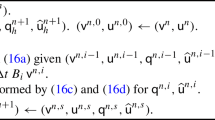Abstract
A least-squares spectral collocation formulation for the Navier–Stokes problem is presented. By this new approach the well known Babušska–Brezzi condition can be avoided. Here we are able to employ polynomials of the same degree both for the velocity components and for the pressure. The collocation conditions and the boundary conditions lead to a overdetermined system which can be efficiently solved by least-squares. The solution technique will only involve symmetric positive definite linear systems. The numerical simulations confirm the usual exponential rate of convergence for the spectral scheme.
Similar content being viewed by others
REFERENCES
Bernardi, C., Canuto, C., and Maday, Y. (1986). Generalized inf–sup condition for Chebyshev approximations to Navier–Stokes equations. C.R. Acad. Sci. Paris 303(2), 971–974.
Bernardi, C., and Maday, Y. (1992). fr Approximations spectrale de problèmes aux limites elliptiques, Springer-Verlag.
Canuto, C., Hussaini, M. Y., Quarteroni, A., and Zang, T. A. (1989). Spectral Methods in Fluid Dynamics, Springer Series in Computational Physics, Springer-Verlag, Berlin/ Heidelberg/New York.
Chang, C. L., and Gunzburger, M. D. (1990). A subdomain collocation/least squares method for linear elliptic systems in the plane. SIAM Numer. Anal. 27(5), 1197–1221.
Chang, C. L., and Yang, S. Y. (2002). Analysis of the L-2 least-squares finite element method for the velocity-vorticity-pressure Stokes equations with velocity boundary conditions. Appl. Math. Comp. 130, 121–144.
Deang, J. M., and Gunzburger, M. D. (1998). Issues related to least-squares finite element methods for the Stokes equations. SIAM J. Sci. Comput. 20, 878–906.
Eisen, H., and Heinrichs, W. (1992). A new method of stabilization for singular perturbation problems with spectral methods. SIAM J. Numer. Anal. 29, 107–122.
Gerritsma, M. I., and Phillips, T. N. (1998). Discontinuous spectral element approximation for the velocity-pressure-stress formulation of the Stokes problem. Internat. J. Numer. Methods Engrg. 43, 1401–1419.
Gottlieb, D., and Orszag, S. A. (1977). Numerical Analysis of Spectral Methods: Theory and Applications, CBMS-NSF Regional Conference Series in Applied Mathematics No. 26, SIAM, Philadelphia.
Haschke, H., and Heinrichs, W. (2001). Splitting techniques with staggered grids for the Navier–Stokes equations in the 2D case. J. Comput. Phys. 168, 131–154.
Heinrichs, W. (1993). Splitting techniques for the pseudospectral approximation of the unsteady Stokes equations. SIAM J. Numer. Anal. 30(1), 19–39.
Heinrichs, W., and Loch, B. (2001). Spectral schemes on triangular elements. J. Comput. Phys. 173, 279–301.
Heinrichs, W. (2003). Least-squares for the spectral approximation of discontinuous and singular perturbation problems.To appear in J. Comput. Appl. Math.
Jiang, B.-N. (1992). A least-squares finite element method for incompressible Navier– Stokes problems. Internat. J. Numer. Methods Fluids 14, 843–859.
Jiang, B.-N. (1998). On the least-squares method. Comput. Methods Appl. Mech. Engrg. 152, 239–257.
Jiang, B.-N., and Chang, C. L. (1990). Least-squares finite elements for the Stokes problem. Comput. Methods Appl. Mech. Engrg. 78, 297–311.
Jiang, B.-N., and Povinelli, L. (1990). Least-squares finite element method for fluid dynamics. Comput. Methods Appl. Mech. Engrg. 81, 13–37.
Orszag, S. A. (1980). Spectral methods for problems in complex geometries. J. Comp. Phys. 37, 70–92.
Proot, M. J., and Gerritsma, M. I. (2002). A least-squares spectral element formulation for the Stokes problem. J. Scient. Computing 17, 285–296.
Rønquist, E. (1988). Optimal Spectral Element Methods for the Unsteady Three Dimensional Incompressible Navier–Stokes Equations, Ph.D. thesis, Massachusetts Institute of Technology, Cambridge, MA.
Author information
Authors and Affiliations
Rights and permissions
About this article
Cite this article
Heinrichs, W. Least-Squares Spectral Collocation for the Navier–Stokes Equations. Journal of Scientific Computing 21, 81–90 (2004). https://doi.org/10.1023/B:JOMP.0000027956.13510.5a
Issue Date:
DOI: https://doi.org/10.1023/B:JOMP.0000027956.13510.5a




